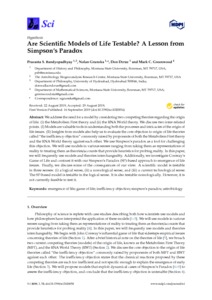Bandyopadhyay, Prasanta S. and Grunska, Nolan and Dcruz, Don and Greenwood, Mark
(2019)
Are Scientific Models of Life Testable? A Lesson from
Simpson’s Paradox.
Sci, 1 (2).
ISSN 2413-4155
![[img]](https://philsci-archive.pitt.edu/16627/2.hassmallThumbnailVersion/Are%20Scientific%20Models%20of%20life%20Testable%20-%20a%20lesson%20from%20Simpson%27s%20Parasdox%2C%20Bandyopadhyay%20et%20al%202019.pdf)  Preview |
|
Text
Are Scientific Models of life Testable - a lesson from Simpson's Parasdox, Bandyopadhyay et al 2019.pdf
Download (517kB)
| Preview
|
Abstract
We address the need for a model by considering two competing theories regarding the origin of life: (i) the Metabolism First theory and (ii) the RNA World theory. We discuss two inter-related points. (I) Models are valuable tools in understanding both the processes and intricacies of the origin of life issues. (II) Insights from models also help us to evaluate the core objection to origin of life theories
called “the inefficiency objection” commonly raised by proponents of both the Metabolism First theory and the RNA World theory against each other. We use Simpson’s paradox as a tool for challenging this objection. We will use models in various senses ranging from taking them as representations of reality to treating them as theories/accounts that provide heuristics for probing reality. In this paper,
we will frequently use models and theories interchangeably. Additionally, we investigate Conway’s Game of Life and contrast it with our Simpson’s Paradox (SP)-based approach to emergence of life issues. Finally, we discuss some of the consequences of our view. A scientific model is testable
in three senses: (i) a logical sense, (ii) a nomological sense, and (iii) a current technological sense. The SP-based model is testable in the logical sense. It is also testable nomologically. However, it is not currently feasible to test it.
Monthly Views for the past 3 years
Monthly Downloads for the past 3 years
Plum Analytics
Altmetric.com
Actions (login required)
 |
View Item |



